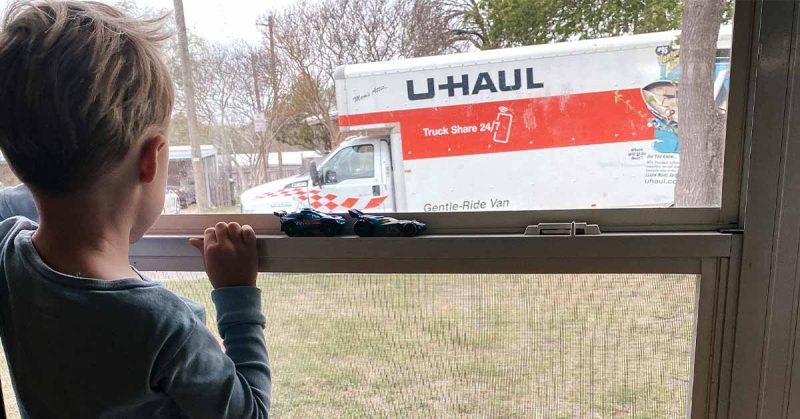This past April, my husband and I did something we thought only crazy people did: a full Do It Yourself, or “DITY” move. While we knew the process would be daunting, we also knew it would be worth it in the end when things were able to go according to our own schedule by moving ourselves, and that we’d be reimbursed by the Army for doing so.
We had absolutely no idea what we were doing, and we went against both of our firstborn natures by winging it on a whim; but overall, it went smoothly, and I thought I’d share some tips we learned along the way that made our lives easier moving with two children three and under.
The Planning:
- Plan your timeline. Everything else will revolve around this. The best way to do this is to work backward. Decide what day you want to arrive at your destination, how long it will take to get there, and what day you need to leave your current residence. Then, you will know when to schedule your truck rental, your move-out inspection, your travel arrangements and your helping hands (if you plan to have family help or stay with family during transit).
- Plan your travel. Make sure to allow yourself enough time to book plane tickets, rent truck equipment, and accommodate for how you’ll get everything and everyone (including pets) to your new home. In our situation, we decided it would be best for our family if I flew our young children (ages 9 months and 3 years) to our destination — rather than putting them in the car for three long days. This was a decision we did not regret. We bought our one-way plane tickets about a month ahead and planned a visit with family as a place to stay while we waited for my husband to arrive at our new home with our belongings. He towed one of our vehicles and brought our dog in the moving truck with him.
- Plan your finances. You’ll certainly make some good money for moving yourselves, but you will have to cover all of the costs upfront. Create a designated space to keep all receipts for moving-related expenses, vehicle weight tickets and per diem costs such as hotel stays and gas. I labeled a plastic bag “Moving Receipts” to keep in each of our vehicles.
- Consider if you want to work with a financial counselor to help take advantage of this as an opportunity to set your finances on a long-term path to success.
- Check your entitlements to understand what is reimbursable.
- Plan your helping hands. Because I flew our kids to our new house, we had to find someone to drive one of our vehicles there. Contact your relocation assistance program through your Military Family Support Center, or by calling MilitaryOneSource, and they can help you with loan lockers or ideas for temporary lodging and more. Luckily, my father-in-law was able to do this for us, and it was the biggest blessing in our move. If you have young children, you should also consider making plans for them to be at someone else’s house, if possible, during the big packing and loading days. Even if you can just get someone to come to the house and take the kids to the playground or out for a fun meal or something, your time will be precious and efficient without having to simultaneously juggle parenting and packing.
It may also be necessary and helpful to plan other help, such as people to help you load boxes and other heavy items onto the truck, as well as a cleaning service to get your house deep cleaned and ready for move-out inspection. This was a lifesaver for us and probably the best thing we did in the entire DITY process. Packing and loading are both exhausting, and the last thing you will want to do is clean every square inch of the house right before you leave it.
The Prepping:
When you’re done planning the logistics of your move, you can begin the actual moving process. My husband and I separated this into three major phases: making the house packable, loadable and leavable.
- Make the house packable (*one month-two weeks prior to moving*). Making the house packable will be easy for some, and harder for others — depending on the state of your home. To make your house packable, you will need to slowly go through everything you own, one closet, one drawer, one nook at a time — purging and organizing every space in your house. This way, you prime the house so that you know everything in it is purposeful and coming along to your next home. It is a waste of time, energy and money to pack things that you don’t want there. It is also very helpful to get this done before beginning the packing process, so that way you aren’t overwhelmed with piles of things to donate, on top of all the piles of boxes as well. Once your home is purged and organized, and as your move gets closer (within two to three weeks), you can begin consolidating small items — such as hair accessories, arts and crafts supplies, kitchen spices, etc. — into gallon-sized bags. That way, when it comes time to pack, you can easily throw bags into boxes and don’t have to worry about small items getting misplaced.
- Make the house loadable (*One to two weeks prior to moving*). Once your home is packable, and you are ready to begin moving your items into boxes, we found it best to focus on one room at a time, leaving the kitchen for last. We began packing up the bathrooms and bedrooms first — leaving out only the necessities. We left an open box in every room to put those last-minute items in. We allowed three days to pack up the kitchen, because we knew it would be a slow process with our two kids and is always the most time-consuming room. Once you’re done packing up a box, make sure to label the room and items, being as specific as you can with what exactly is in each box. Stack the boxes in each room they belong to keep them organized, so you can easily load up one room at a time into the moving truck when it comes time to do so.
- Make the house leavable (*one to two days prior to moving*). Once about 99% of your house is packed up — with only bare minimum things left out like clothes, toiletries, a few food items and cleaning supplies (if necessary) — you can begin loading up the moving truck whenever it’s in your possession. Make sure — when you get your truck — to get dollies and furniture padding. When it comes to loading the truck, pack all the boxes into the truck first, before loading any furniture. This is when you’ll realize it’s very helpful to make sure you get your boxes from the same store, so they are uniform in size and stack well together. When you have all the boxes in the truck, it’s time to begin playing “furniture Tetris,” stacking any square or rectangular furniture like shelves and tables on the bottom, to make a base for the lighter, more odd-shaped items. My husband used to be a professional mover, so he was the one to tackle this task for us. If you hire a cleaning service, you’re pretty much done once all of your belongings are loaded up. If not, you will need to carefully go through your home cleaning all surfaces, appliances, and replacing light bulbs, etc. to make it move-in ready for the next tenants or homeowners.
- And lastly, make your new home. Once you arrive with your belongings at your new destination and get everything unloaded, we have found it best to sort boxes into each room — and then unpack in reverse order of the rooms you packed in your old house. As tempting as it might be to unpack and put away one box at a time, we have found it best to do a full unpack before organizing and putting away any of your belongings. This way, you can get all the boxes and packing paper out of your house and focus on finding a place for all of your items. Getting them all out of boxes will force you to go through everything as quickly as possible, rather than be tempted to let things sit neatly in boxes that may stay packed up forever if you let them.
These are just some things that worked well for us in the planning and prepping stages of our first DITY move, and if anyone else is considering trying it out, I hope some of these tips will come in handy for you, too.





